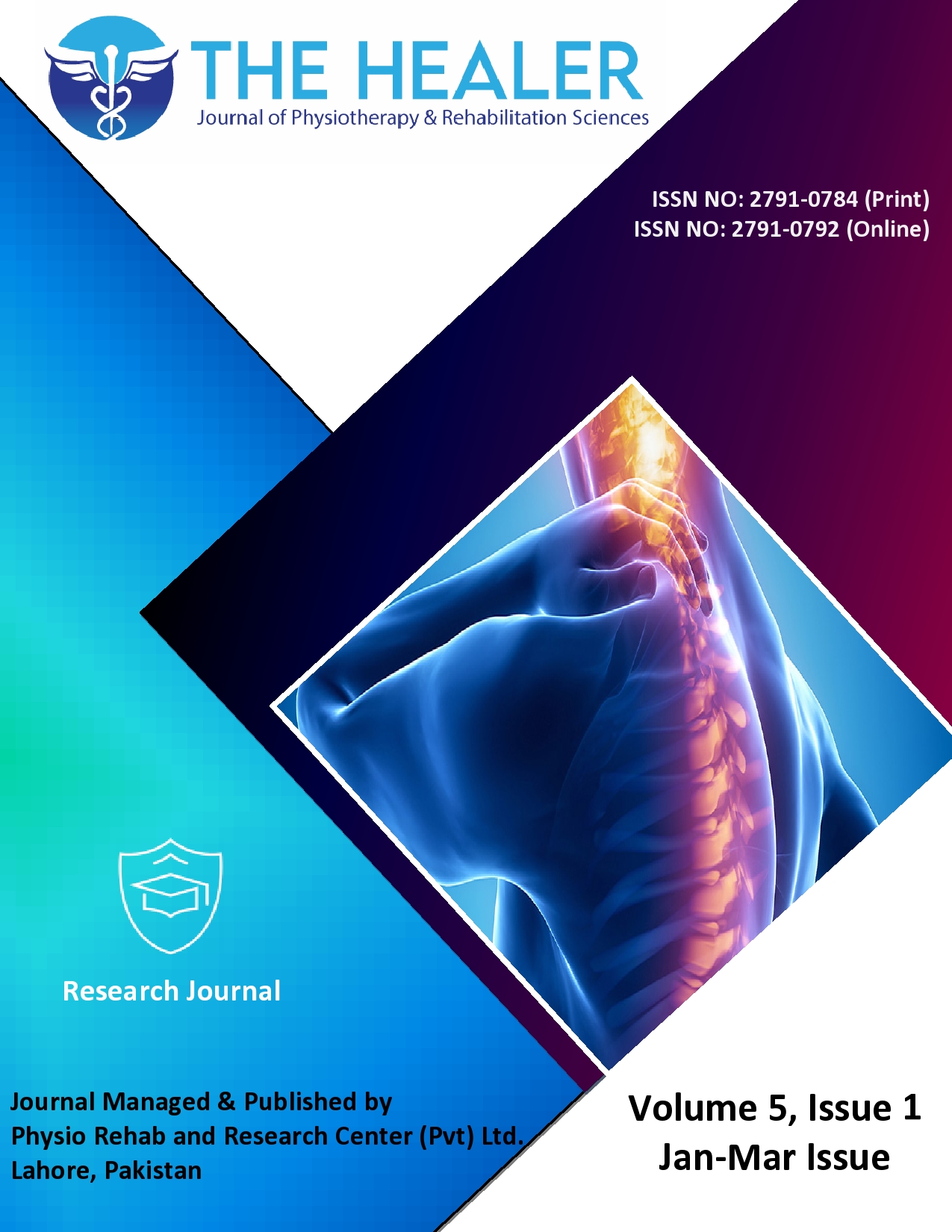Prevalence of Carpal Tunnel Syndrome and Its Risk Factors among Information Technology Students in Sialkot
DOI:
https://doi.org/10.55735/12vk5p36Keywords:
Carpal tunnel syndrome , Information technology , Peripheral nerve disorder , Risk factors , Young adultsAbstract
Background: Carpal tunnel syndrome is a widespread peripheral nerve disorder, particularly common among individuals who engage in repetitive wrist and hand movements. With the rapid increase in the use of digital technology, students in fields requiring extensive computer engagement, such as information technology, are becoming more vulnerable to developing this syndrome at an early age. The constant use of laptops, smartphones, and gaming devices contributes to sustained wrist strain, making carpal tunnel syndrome a growing concern among young adults. Objective: To determine the prevalence of carpal tunnel syndrome and identify associated risk factors among information technology students in Sialkot. Methodology: This cross-sectional study was conducted between March and September 2025 after receiving formal approval from the research ethical committee of the University of Sialkot, conducted on 375 information technology students aged 19 to 25 years who reported using computers or smartphones for a minimum of four hours daily. Before data collection, written informed consent was obtained from all participants after explaining the study objectives, confidentiality procedures, and the voluntary nature of participation. Students having musculoskeletal disorders, injuries, or trauma were excluded. Symptom Severity Scale and Functional Status Scale scores were measured using the validated Boston Carpal Tunnel Syndrome Questionnaire. Inferential statistics were performed using the chi-square test to examine associations between carpal tunnel syndrome and various risk factors. Results: The overall prevalence of carpal tunnel syndrome was found to be 72.3%. Among the affected participants, 48.8% experienced mild symptoms, 19.2% had moderate symptoms, and 4.3% reported severe to very severe symptoms. Statistically significant associations were observed between carpal tunnel syndrome and diabetes mellitus (p<0.001), smoking (p<0.001), hypertension (p=0.002), thyroid disorders (p<0.001), rheumatoid arthritis (p<0.001), and wrist injury (p=0.001). Prolonged gaming (41.3%) and insufficient rest breaks (66.9%) were also linked to reduced functional capacity. Conclusion: The findings indicate a notably high prevalence of carpal tunnel syndrome among information technology students. Lifestyle habits, health conditions, and extended device usage were major contributors, whereas age, gender, and body mass index showed minimal impact.
Downloads
References
1. Majid N, Ismail MAE, Masar ML, Syabariyah S. Mobile games among university students: a symptom and functional severity for carpal tunnel syndrome. Environment-Behaviour Proceedings Journal. 2022; 7(20): 255–60.
https://doi.org/10.21834/ebpj.v7i20.3479
2. Genova A, Dix O, Saefan A, et al. Carpal tunnel syndrome: a review of literature. Cureus. 2020; 12(3): e7333.
https://doi.org/10.7759/cureus.7333
3. Abbas G, Ahmed MB, Almohannadi FS, et al. Prevalence and risk factors associated with carpal tunnel syndrome among Sudanese females: a cross-sectional study. Cureus. 2024; 16(11): e72943.
https://doi.org/10.7759/cureus.72943
4. Stretanski MF, Dydyk AM, Cascella M. Median Nerve Injury. [Updated 2025 Jul 7]. In: StatPearls [Internet]. Treasure Island (FL): StatPearls Publishing; 2025 Jan-. Available from: https://www.ncbi.nlm.nih.gov/books/NBK553109/
5. John N, Zia M, Zahoor R, Raza A. Association of carpal tunnel syndrome with body mass index among university students: carpal tunnel syndrome & BMI among females. The Healer Journal of Physiotherapy and Rehabilitation Sciences. 2024; 4(2): 958–64.
https://doi.org/10.55735/hjprs.v4i2.198
6. Choi JH, Kim HR, Song KH. Musculoskeletal complications in patients with diabetes mellitus. The Korean Journal of Internal Medicine. 2022; 37(6): 1099–1110.
https://doi.org/10.3904/kjim.2022.168
7. Werner RA, Albers JW, Franzblau A, Armstrong TJ. The relationship between body mass index and the diagnosis of carpal tunnel syndrome. Muscle & Nerve. 1994; 17(6): 632–636. https://doi.org/10.1002/mus.880170610
8. Chakor RD, Shejul P, Agarwal N, Pulgaonkar S, Godhane MR. A cross‐sectional study on the prevalence of carpal tunnel syndrome among office workers. Research Journal of Medical Sciences. 2024; 18(12): 7–11.
https://doi.org/10.36478/makrjms.2024.12.7.11
9. Khired Z, Shawish AM, Mojiri ME, et al. Prevalence and predictors of carpal tunnel syndrome symptoms among teachers in Jazan: a cross-sectional study. Cureus. 2024; 16(9): e68458. https://doi.org/10.7759/cureus.68458
10. Faridi TA, Justin N, John M, Badar A, Faheem N. Occupational risk factor for carpel tunnel syndrome related to computer usage: a descriptive cross-sectional study: carpel tunnel syndrome related to computer usage. The Therapist - Journal of Therapies & Rehabilitation Sciences. 2024; 5(1): 37–40.
https://doi.org/10.54393/tt.v5i01.201
11. Hashimoto S, Ikegami S, Nishimura H, et al. Prevalence and risk factors of carpal tunnel syndrome in Japanese aged 50 to 89 years. The Journal of Hand Surgery (Asian-Pacific Volume). 2020; 25(3): 320–327.
https://doi.org/10.1142/S2424835520500356
12. Alduraibi LS, Alsamani RI, Alfayyadh JM, et al. Reported symptoms and associated factors of carpal tunnel syndrome in Qassim region: a cross-sectional study. Cureus. 2023; 15(11): e49385.
https://doi.org/10.7759/cureus.49385
13. Ithnin A, Rajendrana P. A study on the risk level of carpal tunnel syndrome (CTS) due to smartphone use among undergraduates in the faculty of health sciences at the National University of Malaysia. Journal of Occupational Safety and Health. 2022; 19(1): 39-46.
14. Zethira AT, Hendrati LY. The relationship between online gaming habits with carpal tunnel syndrome among high school students in Jakarta. Medical Technology and Public Health Journal. 2024; 8(2): 150–158.
https://doi.org/10.33086/mtphj.v8i2.5905
15. Demissie B, Yenew C, Alemu A, et al. Carpal tunnel syndrome and its associated factors among computer user bankers in South Gondar Zone, Northwest Ethiopia, 2021: a cross-sectional study. BMC Musculoskeletal Disorders. 2023; 24(1): 828.
https://doi.org/10.1186/s12891-023-06918-5
16. Feng B, Chen K, Zhu X, et al. Prevalence and risk factors of self-reported wrist and hand symptoms and clinically confirmed carpal tunnel syndrome among office workers in China: a cross-sectional study. BMC Public Health. 2021; 21(1): 57.
https://doi.org/10.1186/s12889-020-10137-1
17. Abuharb AI, Almughira AI, Alghamdi HK, et al. Prevalence, awareness, and management of carpal tunnel syndrome among diabetic patients. Cureus. 2024; 16(2): e53683.
https://doi.org/10.7759/cureus.53683
18. Nowak W, Znamirowska P, Szmigielska N, et al. Risk factors for carpal tunnel syndrome. Journal of Pre-Clinical & Clinical Research. 2023; 17(3): 167-170
https://doi.org/10.26444/jpccr/168559
19. Doh CH, Kim YJ, Kim JK, et al. Association of carpal tunnel syndrome risk factors with treatment modality selection focusing on corticosteroid injection and surgery: a nationwide population-based study. Medicine. 2024; 103(16): e37781.
https://doi.org/10.1097/MD.0000000000037781
20. Yesuf T, Borsamo A, Aragie H, Asmare Y. Prevalence of carpal tunnel syndrome and its associated factors among patients with musculoskeletal complaints: a single-center experience from Eastern Ethiopia. BMC Musculoskeletal Disorders. 2025; 26(1): 667.
https://doi.org/10.1186/s12891-025-08859-7
21. Asif S, Firdous A, Tahir R, et al. Prevalence of carpal tunnel syndrome among tailors: prevalence of carpal tunnel syndrome. Pakistan BioMedical Journal. 2024; 7(7): 24–28.

Downloads
Published
License
Copyright (c) 2025 The Healer Journal of Physiotherapy and Rehabilitation Sciences

This work is licensed under a Creative Commons Attribution 4.0 International License.














